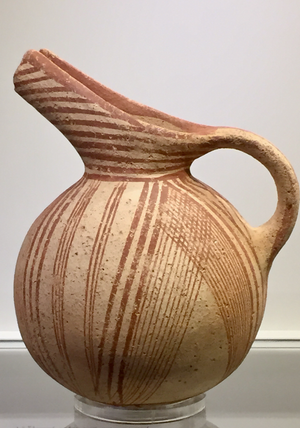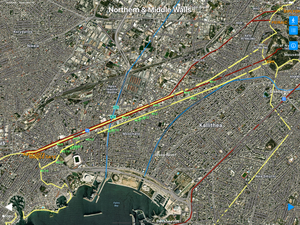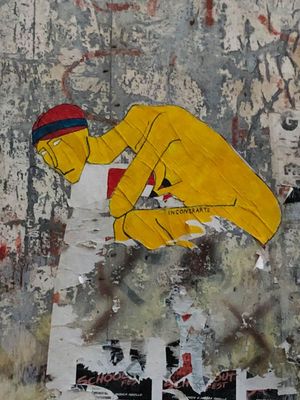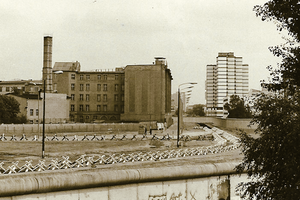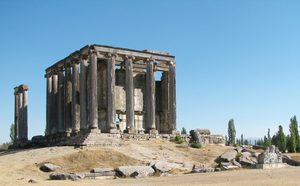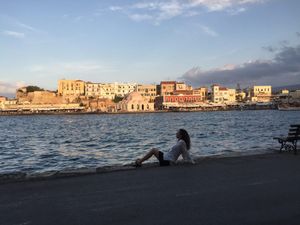This article was originally posted on Electrum Magazine.

Setting
The Minoan civilization often evokes thoughts of myths of the bull-headed Monitor and his labyrinth, visual images of the ruins of the Knossos palace, with its red, tapered columns and advanced multi-storied architecture, their early written languages, the untranslated Linear A and translated Linear B as well as their gold necklaces, earrings and rings and elaborate, colored frescos and bronze and ivory figurines, often depicting women in positions of authority or power.
One might not recall as readily their pottery, unless of course you have been to the Heraklion Archaeology Museum, Crete, which houses by far the largest collection. As a ceramist, I was inspired by the beauty of their work and wanted to learn more.
Minoan pottery is artistically advanced in form and decoration. It is playful, often abstract, often reflecting nature, and enduring while also exhibiting a high level of technical craftsmanship and utility.
Archaeologically, Minoan pottery is one of the few artifacts available to us today which was produced and preserved continuously in time, which makes it a critical temporal marker of the Minoan historical record, such that, the sequence of Minoan pottery helps inform Minoan chronology.
The Minoan civilization was centered on the island of Crete (Figure 1), the largest and southernmost island in the Aegean Sea, encompassing the vast period of 3000 – 1100 BCE, a remarkable span of 2100 years, where they flourished autonomously before being assimilated into the Mycenaean culture from the mainland to the northwest.
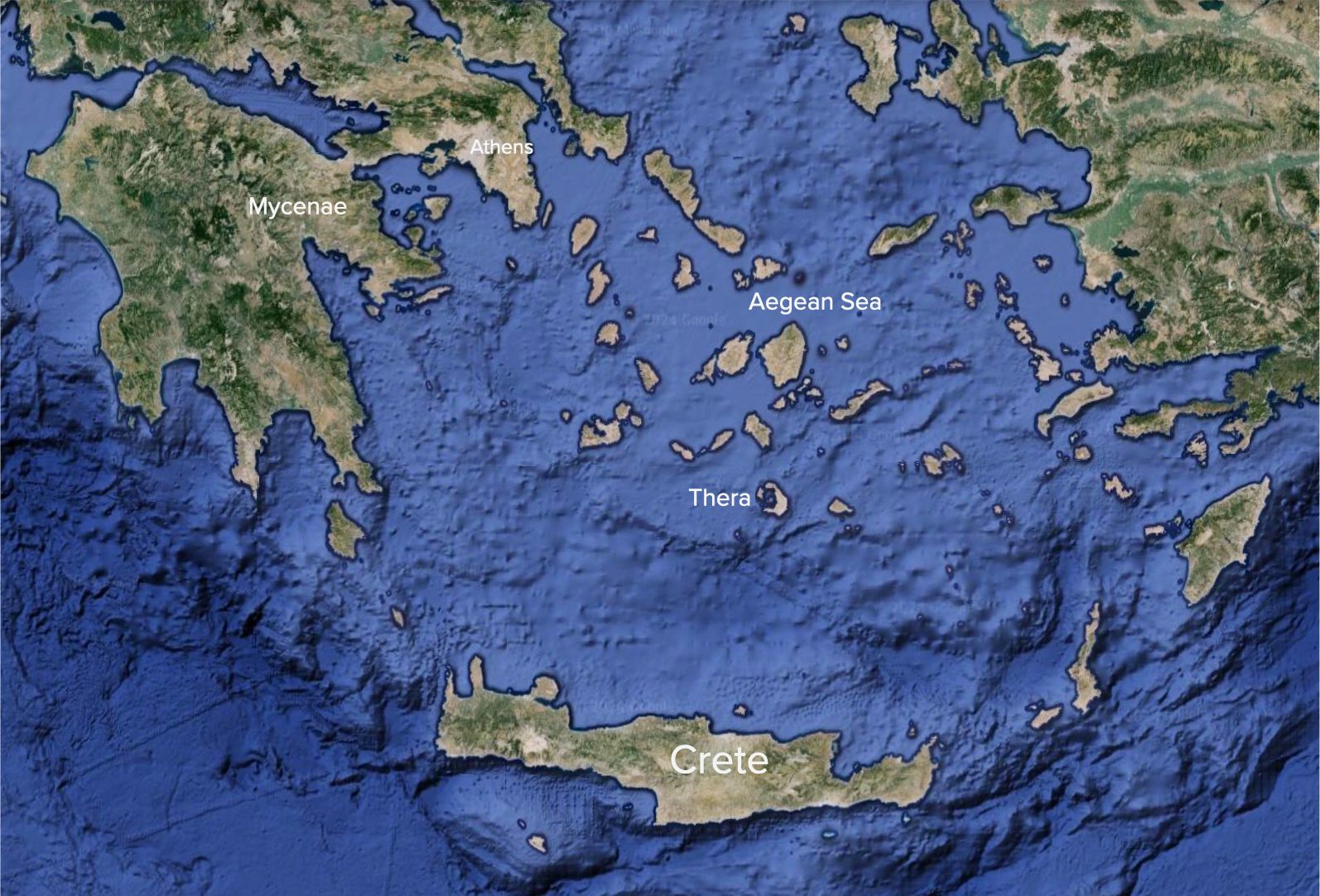
For temporal reference, the Trojan War occurred approximately 1200 BCE, near the end of the Minoan period, and 800 years before the more familiar Classical period of Athenian Greece.
Crete was well positioned to develop an advanced culture. Geographically it was far enough away to limit conflicts with nearby and flourishing Mediterranean cultures, which allowed for independent cultural development. Minoan cities were rarely fortified, yet well positioned for advantageous foreign interaction, trade and immigration. A large and geomorphologically diverse island in a Mediterranean climate, Crete possessed abundant natural resources on land and sea to sustain a growing population.
Minoan Pottery
From the late Neolithic period into the Minoan Bronze age, imported advancements in kiln technology improved the Minoans craft in pottery and became a catalyst to their economic advancement. Pottery was an essential daily commodity. The kiln advancements ensured that new wares were harder, denser and more durable. This allowed for better storage of primary and secondary food product, longevity of use, and expanded shipping and trading options, which ultimately allowed for population growth and wealth accumulation.
There are three general features to consider when reviewing Minoan pottery. 1) The pottery form or shape, and by association, its use. 2) The paint, and how it is decorated, such as the colors and how they are applied and layered, and indirectly, how it is fired. And 3) the motif, the patterns, large and small, abstract or representing nature, that are painted and reproduced, from piece to piece and over time. These three features reflect both the evolution of innovation and the style of the time.
The following presentation of Minoan pottery is organized chronologically, following the standard Early, Middle and Late Minoan dating convention, with its numerous subdivisions (See Appendix II for a complete summary) and provides a broad pictural overview of the exemplary samples of Minoan ware over time. A brief historical setting is also provided.
Early Minoan 3000 – 2100 BCE / Pre-Palatial Period
The Early Minoan period is a long 900-year timespan occurring prior to the Minoans building their first famous palaces. People worked their land and lived in villages and small towns. Evidence implies a more egalitarian environment than the more socially stratified and centralized structures that developed later.
It’s a period in which new groups of people arrived and intertwined with the established island inhabitants, and cross-draft kiln technology was introduced and adopted and caused notable breakthroughs from the Final Neolithic ceramic product into a superior and distinctly different ceramic product.
Only hand building methods were available to the potter during the Early Minoan. By approximately 1900 BCE, the pottery wheel became available, 200 years into the Middle Minoan period.
Early Minoan I, 3000 – 2600 BCE
Techniques did not change overnight, and older styles persisted in time and location while new styles were invented and developed. This is generally true throughout the entire Minoan period.
Final Neolithic pottery styles were fired in enclosed pit-kilns in which the burning wood encased the ceramic pieces. Pit-kilns fired to lower temperatures than the new cross-draft kilns and had little control of the atmosphere within the kiln. Pit-kiln fires resulted in comparatively porous clay bodies. To combat this, prior to firing, the ware was painted in an iron-based slip (a mixture of fine clay and water) and burnished (smoothed with a stone) to form a barrier to better contain liquids. Fired in a non-oxygenated (reduction) environment, the iron slip would turn grey, brown or black.
Two notable Final Neolithic / Early Minoan pottery styles are 1) Pygros or Burnished Ware, which was painted in slip, burnished and fired in reduction. The slip was applied non-uniformly to provide artistic contrast. And 2) Scored or Incised Ware, which was similarly prepared and fired, covered entirely in slip, and was scored or incised in decorative ways.
Figure 2 presents examples of these types of Final Neolithic / Early Minoan pottery.
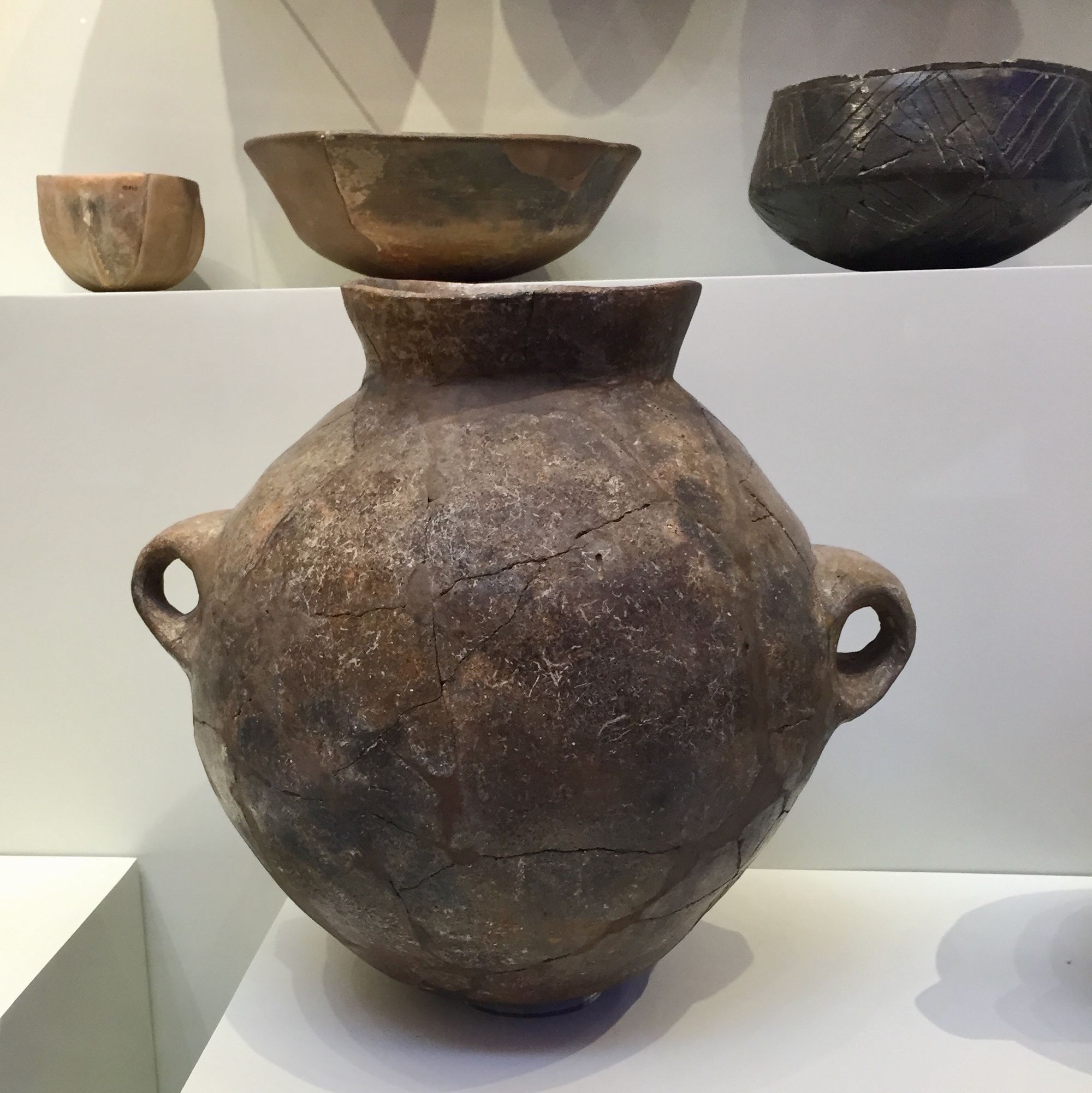
The new styles of the period are strikingly different and unique to Crete. The most famous is Aghios Onoyphrios Ware, named after the archeological site from which it was found.
The cross-draft kilns allowed for higher firing temperatures and more even temperature distributions as the fire was situated away from the pottery within the kiln. This produced denser and more durable pottery and allowed for larger pieces to be constructed. The kiln atmospheres could also be controlled, allowing non-oxidation (reduction) and now, oxidation environments, interchangeably during firing, new levers that allowed for more options of decoration. New clay bodies and preparation methods were required to support the new kilns.
Figures 3 and 4 display the most well-known Aghios Onoyphrios examples. If you have seen pictures of Minoan pottery, you likely saw one of these.
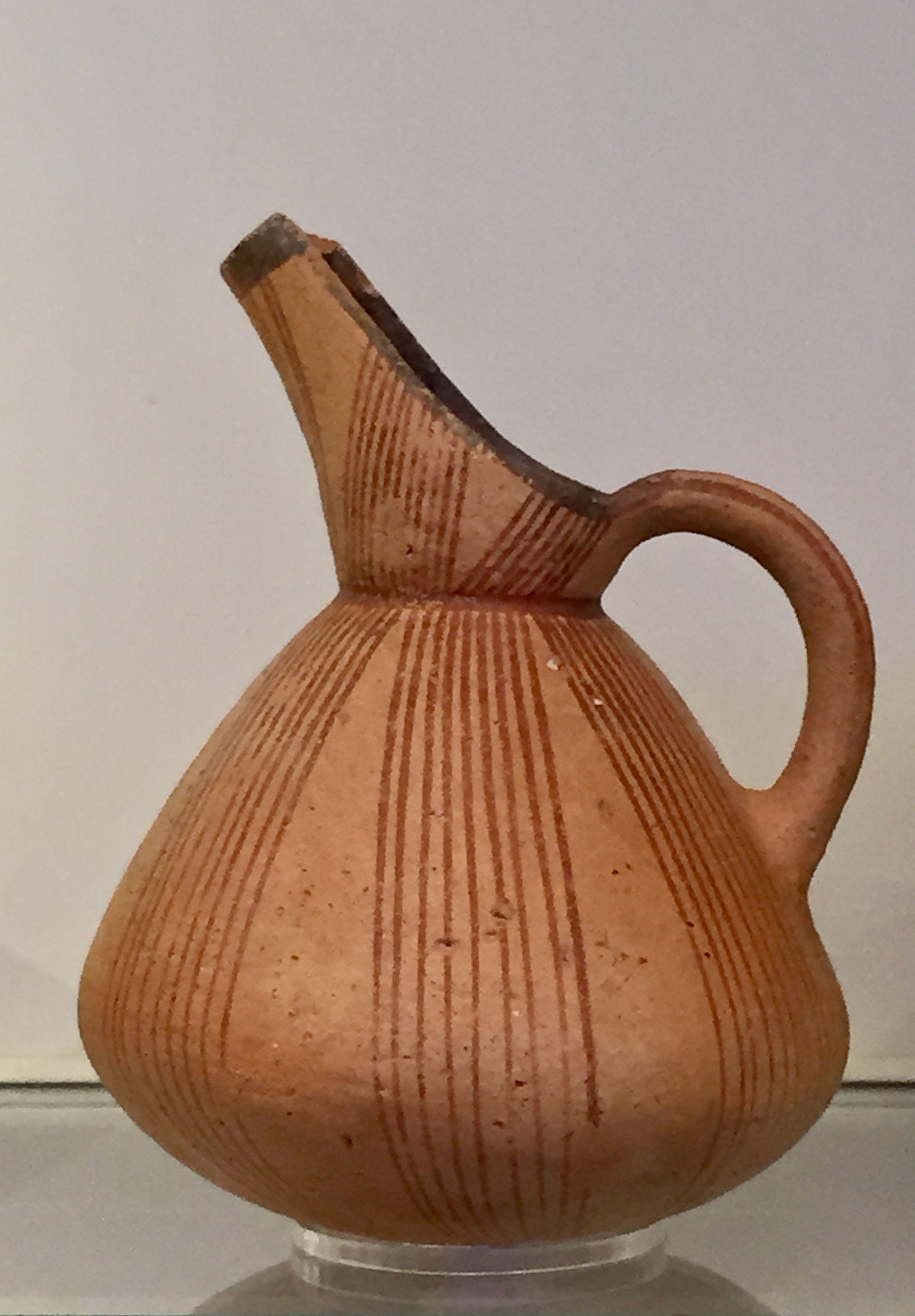
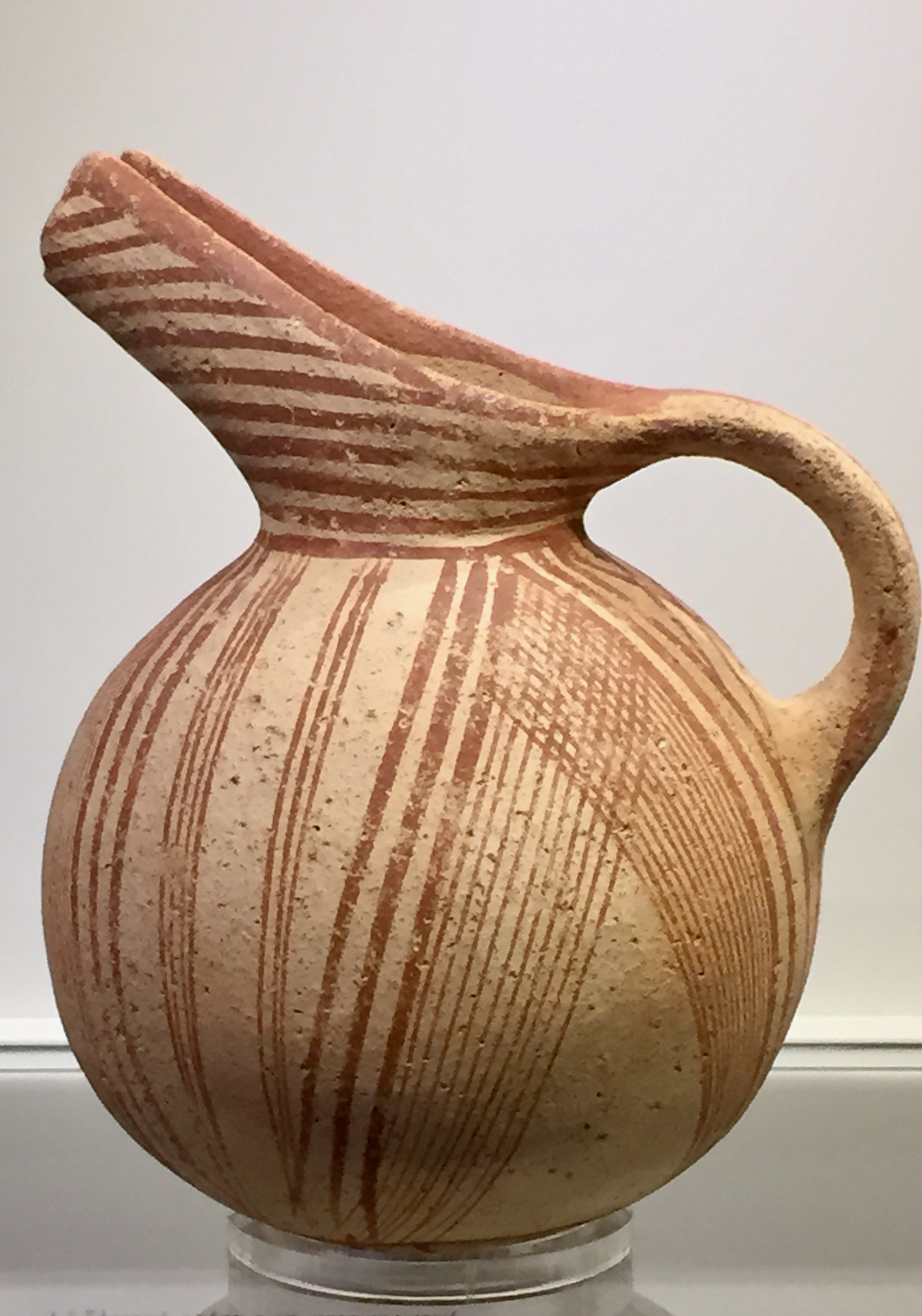
The pieces were painted almost entirely in a near-white slip on a pale firing clay. Linear lines of red-iron slip were delicately painted, and when fired in oxidation, turned red instead of black. The white slip, having no iron content, retained its color. It’s been suggested the forms are inspired by the shapes of gourds and the linear lines are abstractions of strings or nets used for suspension.
The renowned expert of Minoan pottery, Philip Betancourt reports, this is the period where
"the ceramicist has graduated to a position of special craftworker ... and in many ways is a high point in our artistic heritage."
Lebena Ware is the other well-known new style. It is like Aghios Onophrios Ware except the slips are inverted, with white slip painted on top of an iron-based slip which covered the entire clay body and turned red upon firing (Figure 5).

The new wares show profound advancements in style and technique as the Minoans learned how to work their new clays, slips and kilns.
Early Minoan II, 2600-2300 BCE
In this period, as experimentation improves technique, there is a marked improvement in quality of the wares produced. Prior styles persist and then fade away to be replaced with new styles. Changes do not occur at the same time across the island, but cross island influences are apparent.
In the early part of EM II, Fine Gray Ware, a well-made gray colored ware, often with abstract scoring or incisions, and Koumasa Ware, a modest variation of Aghios Onoyphrios Ware, are prevalent.
By the later part of EM II, Vasilike Ware is in “vogue” (Figure 6), apparently at the expense of Fine Gray Ware and Koumasa Ware.

Vasilike Ware exhibits a mottled, meaning marked with spots or smeared with color, decoration that is a result of controlled, uneven firing. The affect was achieved by variation in the application of fine-grained slip and/or using an oxidized/reducing inversion in the kiln.
Popular island wide, it has a retro feel because it implies a desire to create an “uncontrolled”, perhaps more “ancient” or at least “random” look, ironically, using the new techniques of control in the kiln.
Early Minoan III, 2300-2100 BCE
Not much Vasilike Ware is found in EM III, which is dominated by a new White-On-Dark Ware with white designs on a dark background (Figure 7).

With exaggerated spouts, its decoration employs a wide variety of white painted motifs consisting of straight and curved lines, semi-circles and wavy lines and various rectilinear designs on an iron slip background, fired in reduction.
Middle Minoan, 2100-1600 BCE
The 500 years of the Middle Minoan saw the introduction of monumental palaces at Knossos, Phaistos, Malia, and other sites, and more importantly, a new type of centralized society that created many changes. The new palaces acted as redistribution centers of agricultural and other commodities that required large quantities of clay containers. The potter’s wheel sped up the production process, but perhaps more importantly, standardization appears, implying more supervised craft.
Palace rulers were interested in the visual arts and thus the palaces became especially important to Minoan art, drawing artists towards them and who were directed by them. Palatial styles were not restrictive, but creative, and produced wares of incredible culture, sophistication and beauty.
Middle Minoan IA, 2100-1900 BCE
The MM 1A was the final period of purely handmade pottery before the introduction of the potter’s wheel.
During this period, polychromy decoration, painting in several colors, was introduced, with the addition of red paint. Figure 8 shows an example of Red on White-On-Dark Ware.

The Light-On-Dark style persists into MM I, and its inversion White-On-Dark Ware appears (Figures 9 and 10).
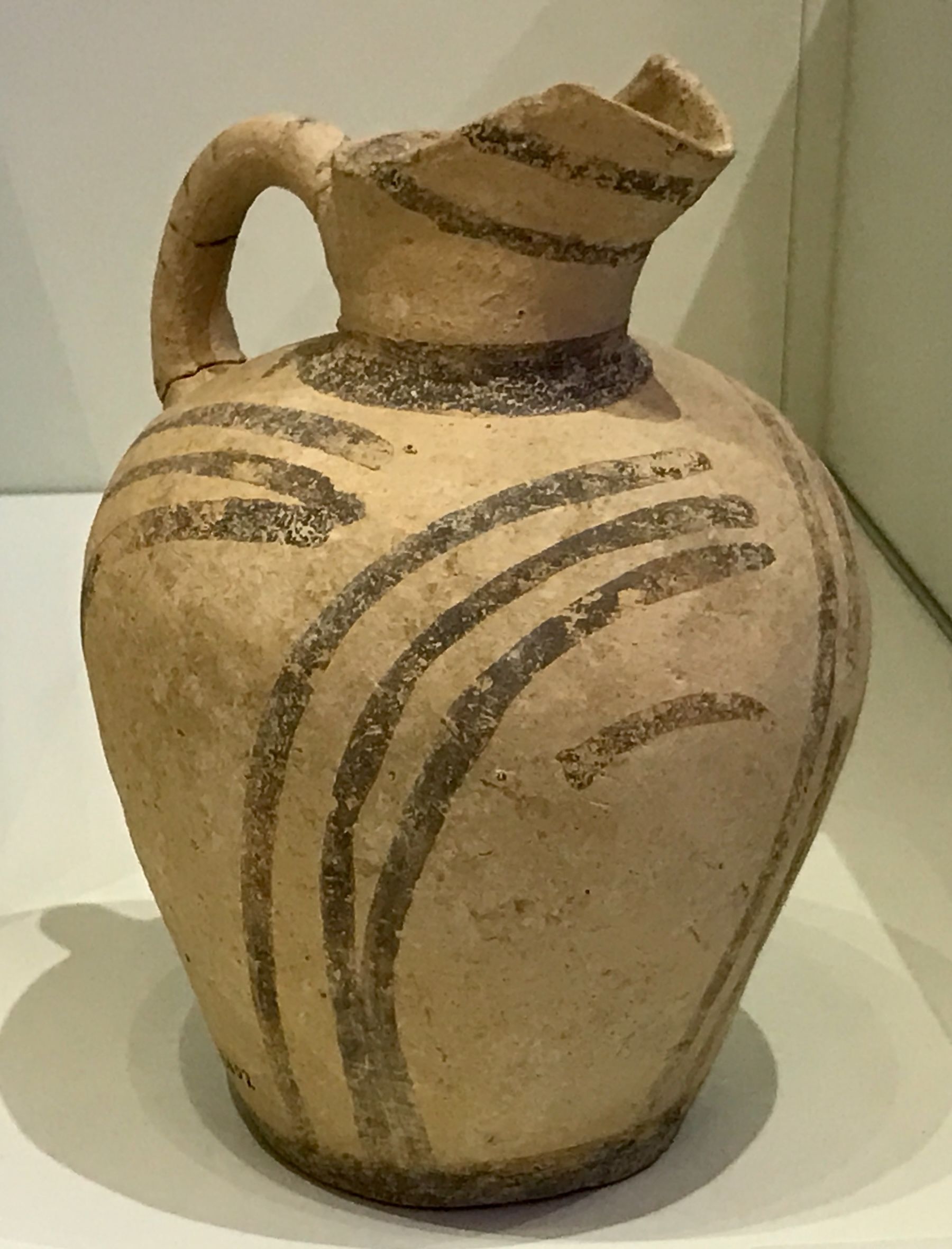
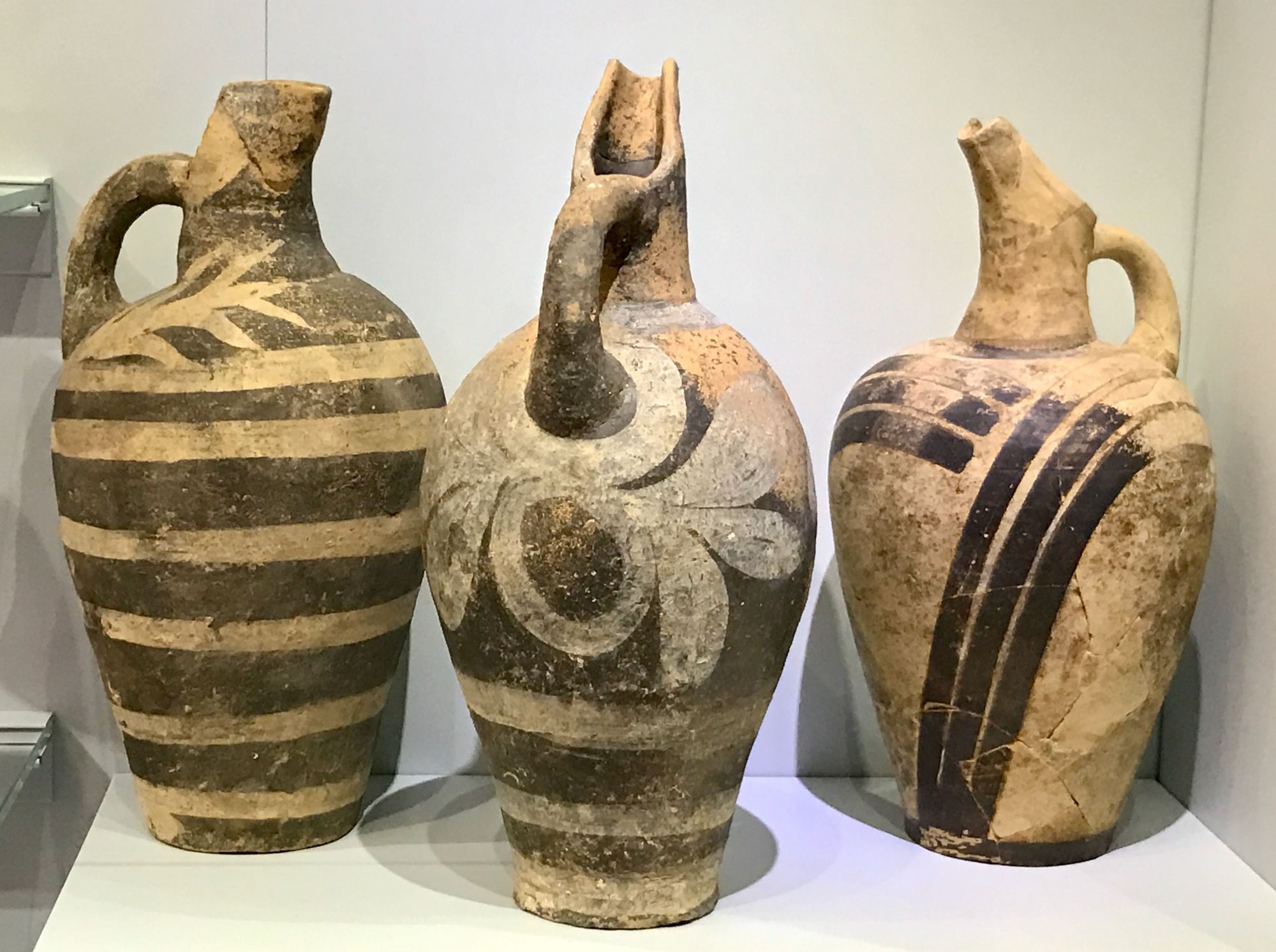
Middle Minoan 1B, 1900 – 1800 BCE / Proto-Palatial Period
The Minoans did not invent the potter’s wheel, it was known in other parts of the Aegean prior to becoming widespread on Crete during MM 1B. Its introduction is a good chronological marker as turned-ware is easily identified compared to hand-built ware.
This period is known for the three-dimensional Barbotine Ware (Figures 11 and 12).

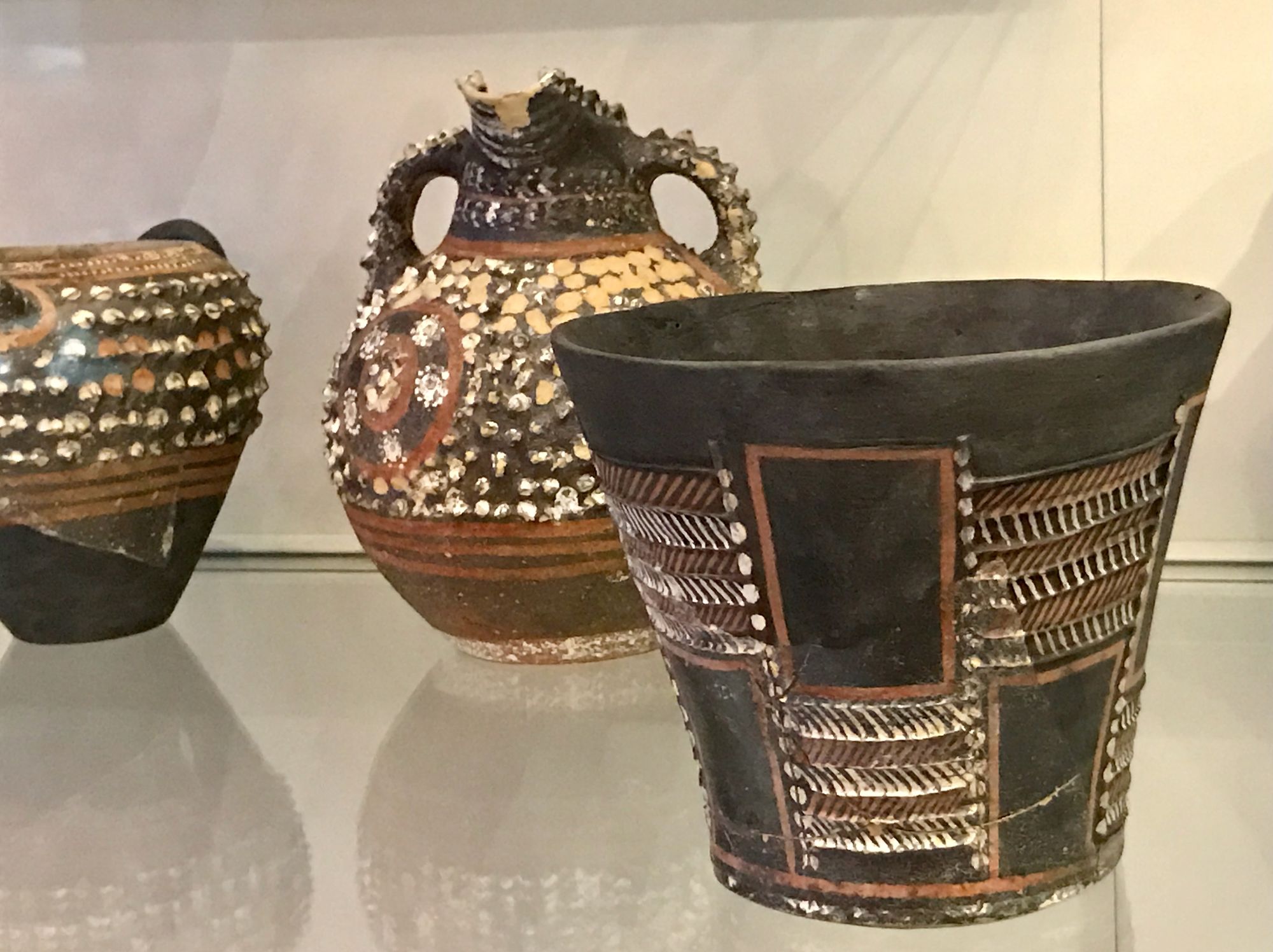
Several types of barbotine decoration exist. Wave Barbotine consists of long ridges, either applied or worked up from the surface of the vase. Dabs of slurry, named Barnacle Work are usually applied to broader area. Small points of clay are known as prickles.
Middle Minoan II, 1800-1700 BCE
At this time, Minoan pottery was primarily created for domestic use and was not yet widely exported.
Kamares Ware is the dominant ware during MM II and is perhaps the most revered of all Minoan ware. Produced primarily from the palaces of Knossos, Phaistos and Malia, it is high-quality, wheel-made pottery. The style was not heavily replicated in the provinces, which continued to produce prior styles.
Kamares Ware is bold, possessing the characteristics of polychromy with red, crimson, orange, yellow and off-white added to white and dark slip painted on pale clay. Floral and faunal motifs appear for the first time as does more complex ornamentation and syntax that break from the traditional linear motifs. Kamares Ware expresses a high level of inventiveness, creativity and individual uniqueness of pieces.
Bentacourt calls this ware
“major monuments in the history of ceramic art.”
A few of the many Kamares Ware pieces are displayed in Figures 13, 14, 15 and 16. They are gorgeous.
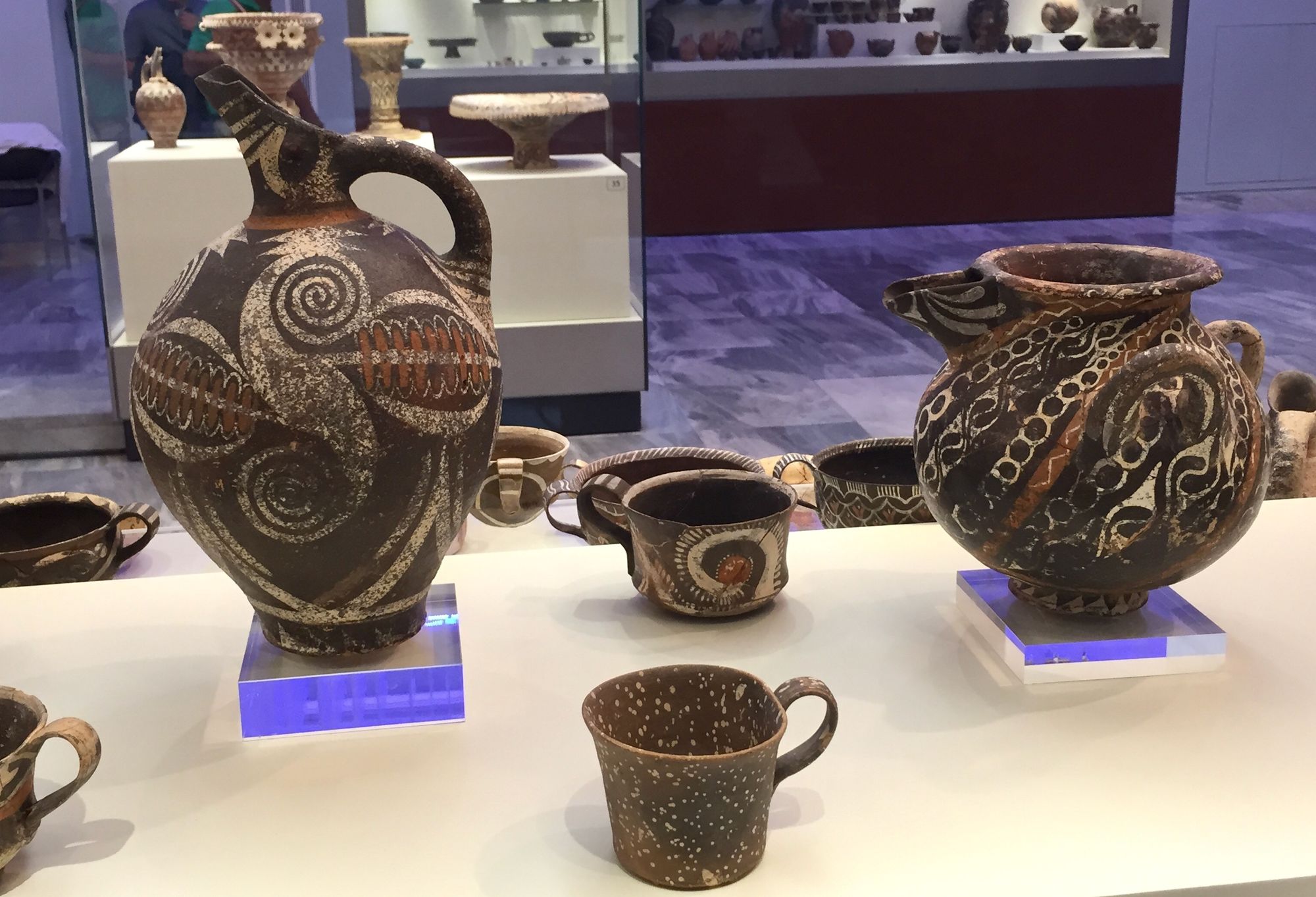
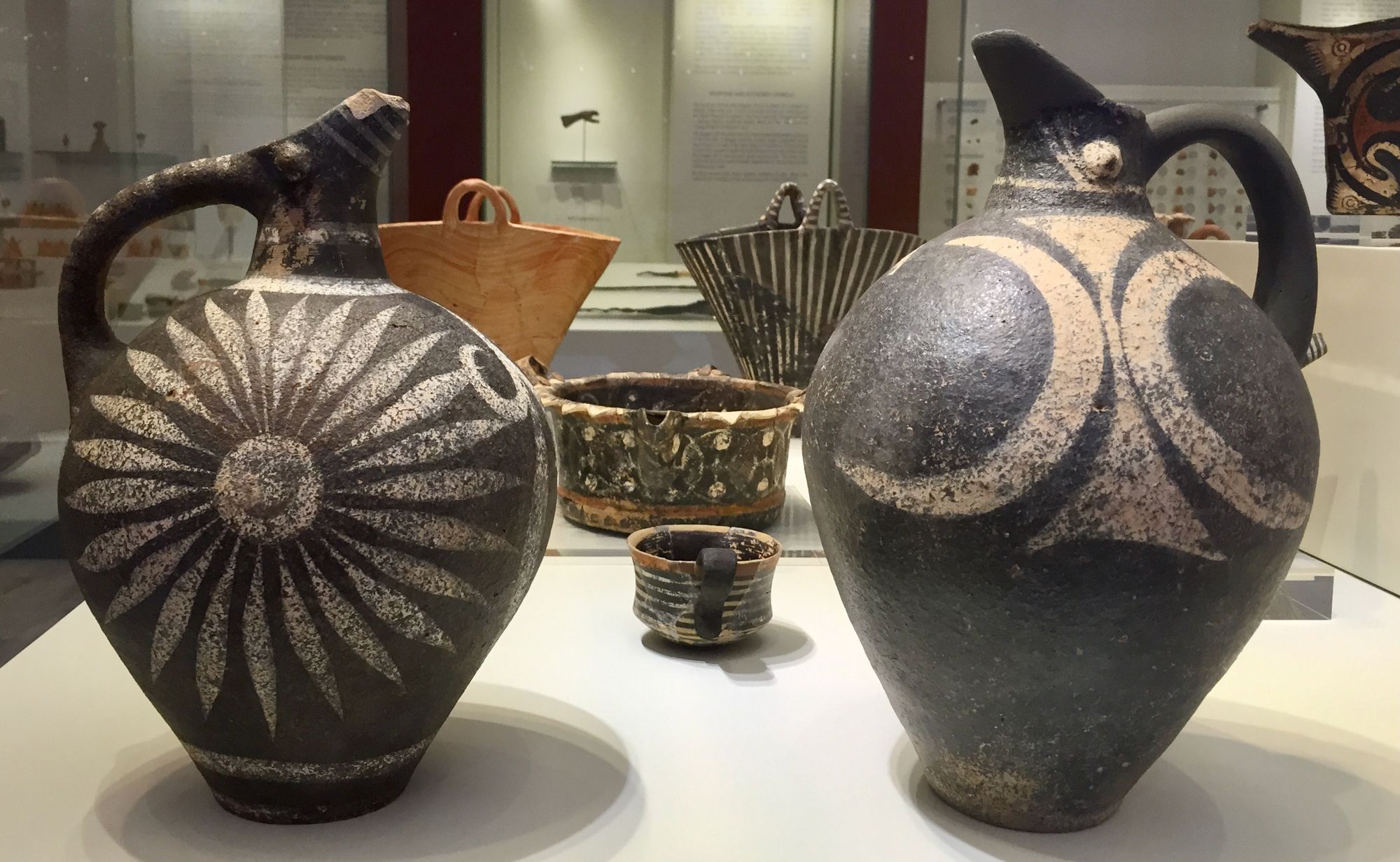
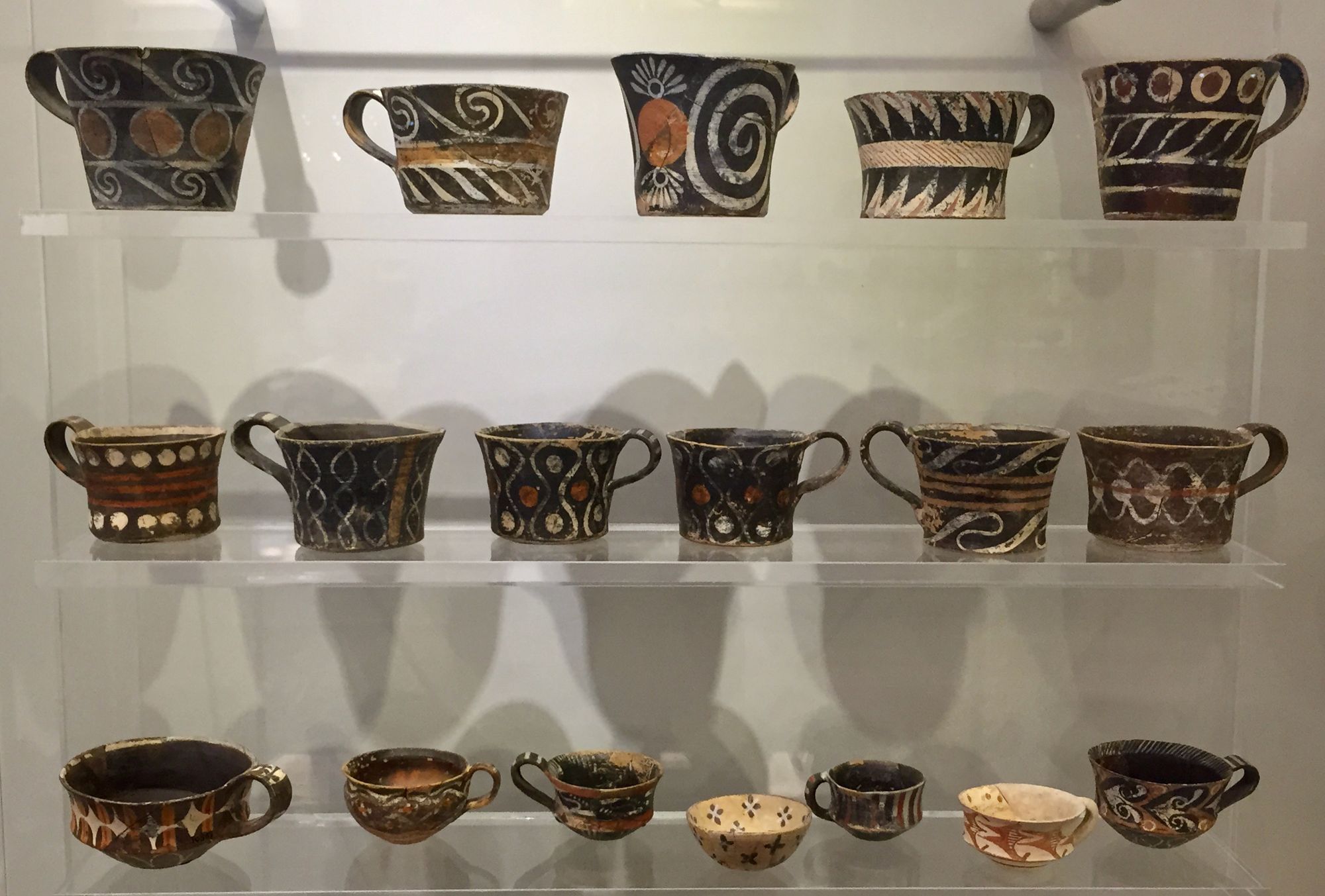
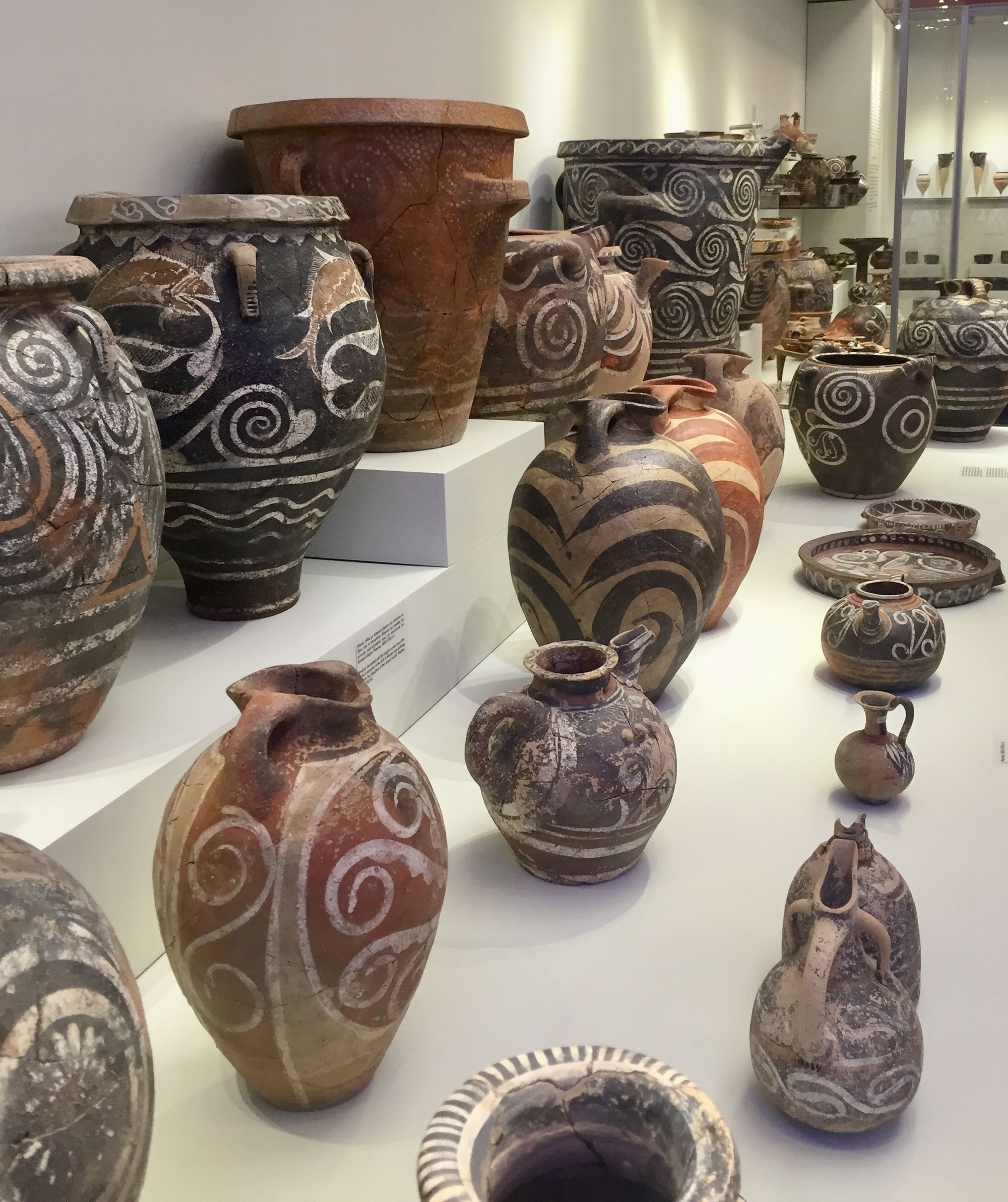
Middle Minoan III, 1700 – 1600 BCE / Neo-Palatial Period
Evidence exists in late MM II of wide earthquake destruction and followed quickly by elaborate rebuilding at the major palaces located in central Crete. Thus, MM III is known as the Neo- or New- Palatial Period, producing the most elaborate and wealthy palace societies yet.
Surprisingly, whether a direct consequence of the new palace constructions, or something else, MM III represents an unexpected and unexplained recession in ceramic style and technology. Little is known of the western styles and the eastern styles seem to have remained provincial without a break.
The exception is Tortoise-Shell Ripple Ware, from the central palaces, a lustrous, dark-on-light pottery that employs a newly formulated, very fine, iron-based slip that fires a rich reddish-brown and has a glossy, reflective appearance, enhanced by burnishing. It occurs in small quantities but is found throughout Crete and was exported (Figure 17). Its prevalence expands into Late Minoan I.
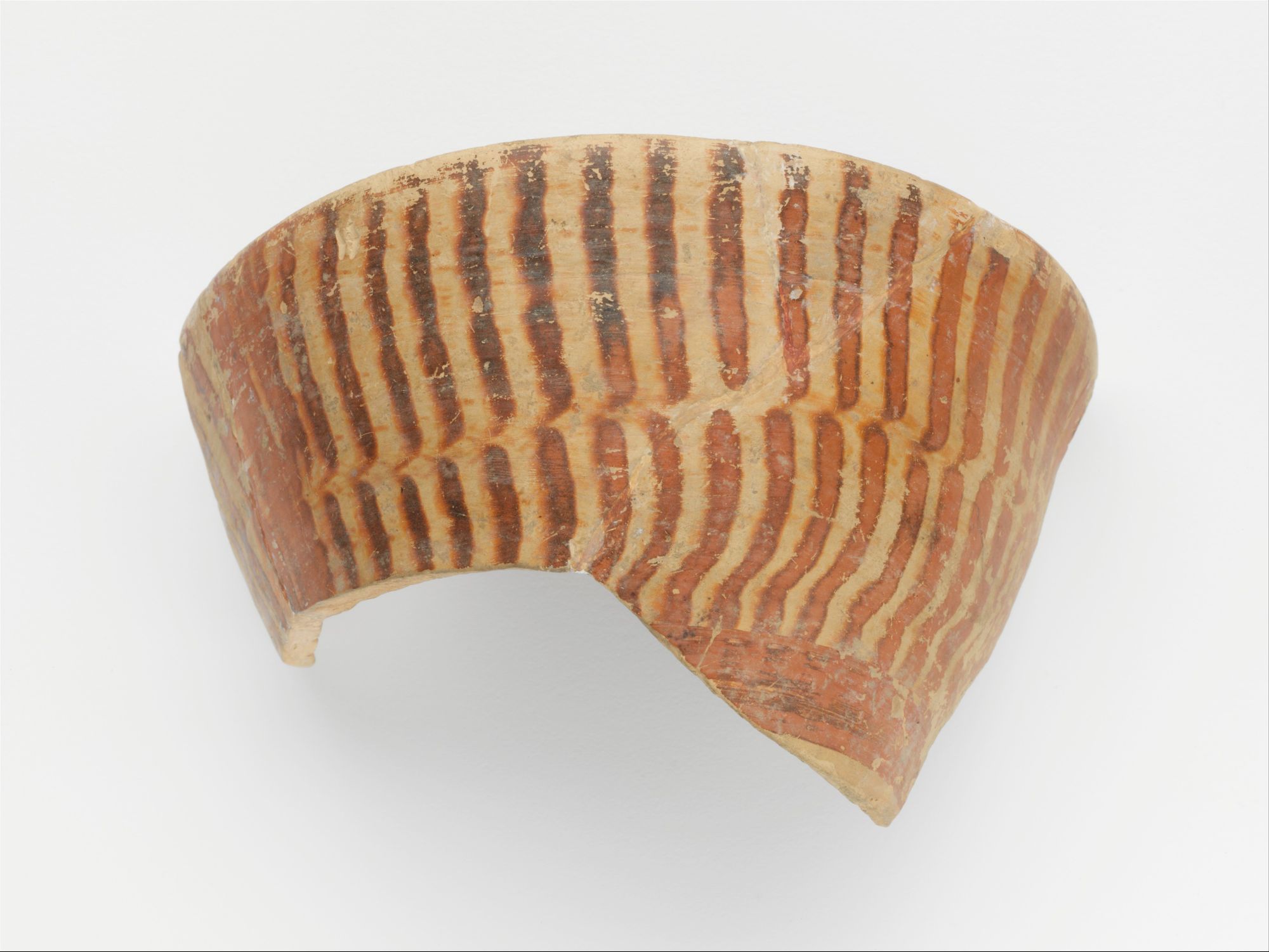
Late Minoan, 1600 – 1100 BCE
The final 500 years of the Minoan civilization includes their economical and artistic peak. The population is large, pottery is exported widely, and outposts of Minoan culture are flourishing in the Aegean. It’s possible Crete was now ruled by a single power, surly by a series of palatial oriented regional centers, with a well-organized bureaucracy. Evidence for fortifications remains minimal. It’s noteworthy that there are no depictions of warfare anywhere in Minoan art.
It was a time of relative peace. Until it was not.
This period also marks the end of the Minoan civilization. By the end of the Late Minoan the palaces were destroyed and deserted, and the people retreated from the coast into the foothills and mountains and any prior form of island wide organization crumbled.
The cause of decline remains uncertain. The Dorian invasion, Greeks from the far north, is attributed to sending all the prior Aegean civilizations of the time, including the Mycenaeans, into a Dark Age that lasted 400-500 years. But this event is unlikely the cause of the Minoan demise and more likely is responsible for its permeance.
Many theories remain in play. Natural disaster is a viable cause. The island of Thera (Santorini), located just 90 kilometers north of Crete, exploded violently somewhere near 1600 BCE (until recently ~1525/1500 BCE was the accepted date range), spawning tidal waves, causing earthquakes and spewing crop ruining ash across a vast area. It caused an economic and cultural disruption, but exactly how severe remains uncertain.
What followed is postulated to be more natural disaster, and/or invasion, the Mycenaean’s being the most likely candidate, and/or internal strife caused by the hardships of the prior disasters. What is for sure is the Minoan culture did decline and end during this period, slowly, and had shining moments in ceramics and otherwise to the end.
Late Minoan I, 1600 – 1450 BCE
Larger, Type II Channel kilns begin to appear (see section below), allowing even more control of the firing process and led to observably finer product. Advancement in this area continued though Late Minoan III.
Stylistic changes also occurred with a new emphasis on design and natural forms, often in abstract or semi-abstract ways.
Describing the ware of this period Betancourt says
“…one can detect an exuberant joy in nature.”
The greatest theme of LM I, rivaling Kamares Ware in artistic achievement, is called the Special Palatial Tradition, a term applied to a group of decorative styles named the Marine Style, Floral Style, Abstract and Geometric Style and the Alternating Style. While defined separately, these approaches are often found in combination on a single piece.
They were produced by the palace workshops, and for the first time, the work of individual craftspeople can be recognized.
The Marine Style is playful and joyous. Figures 18 and 19 show a common element of the octopus, which is well suited for painting on a curved surface. Triton shells, seaweed, sea urchins and corals are seen in accompaniment.
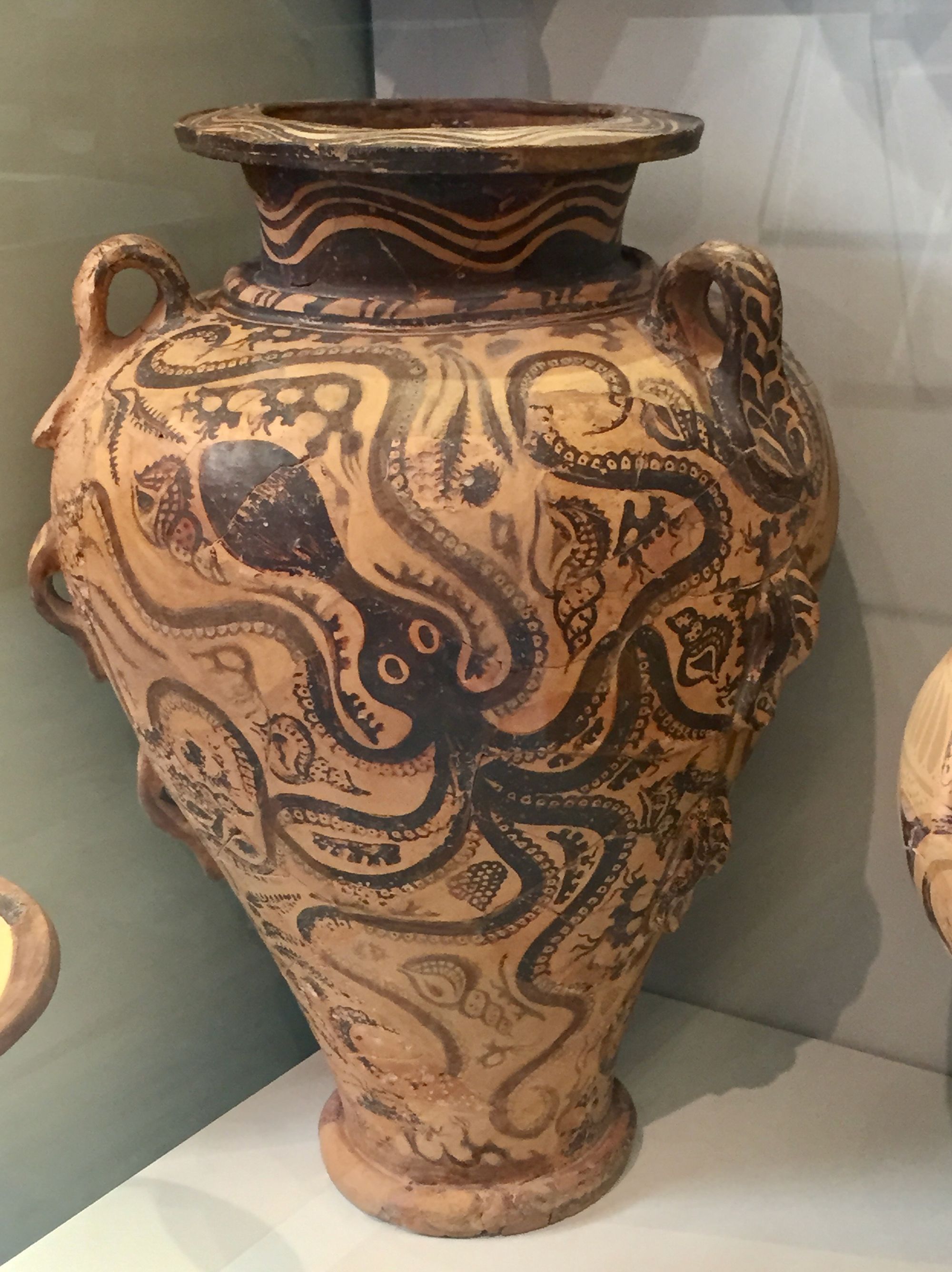

The Floral Style has a wide range and can vary from serene imagery to the very complex (Figures 20 and 21).
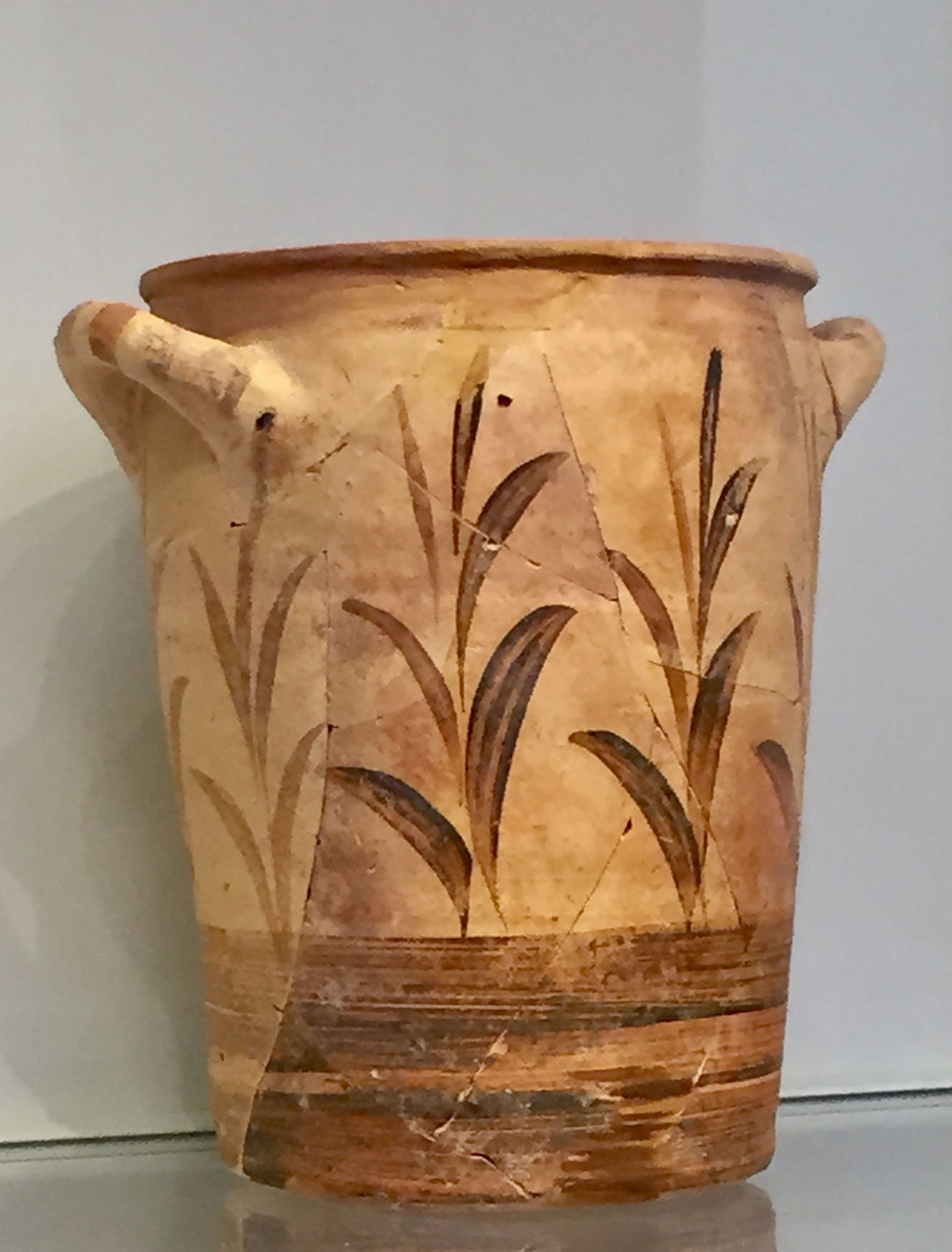
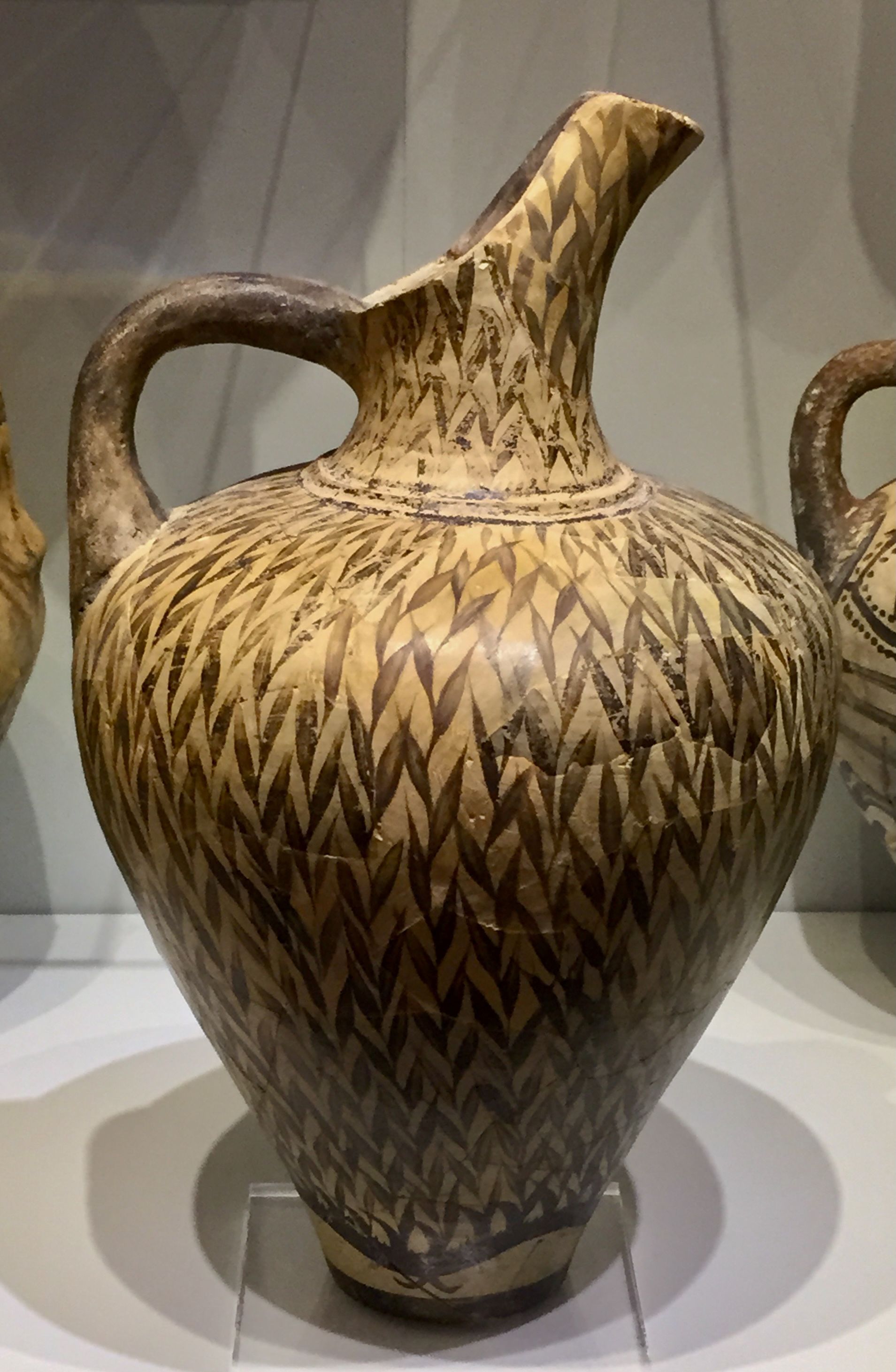
The Abstract & Geometric Style represents a maturation and synthesis of prior abstract and pattern-based motifs (Figure 22).
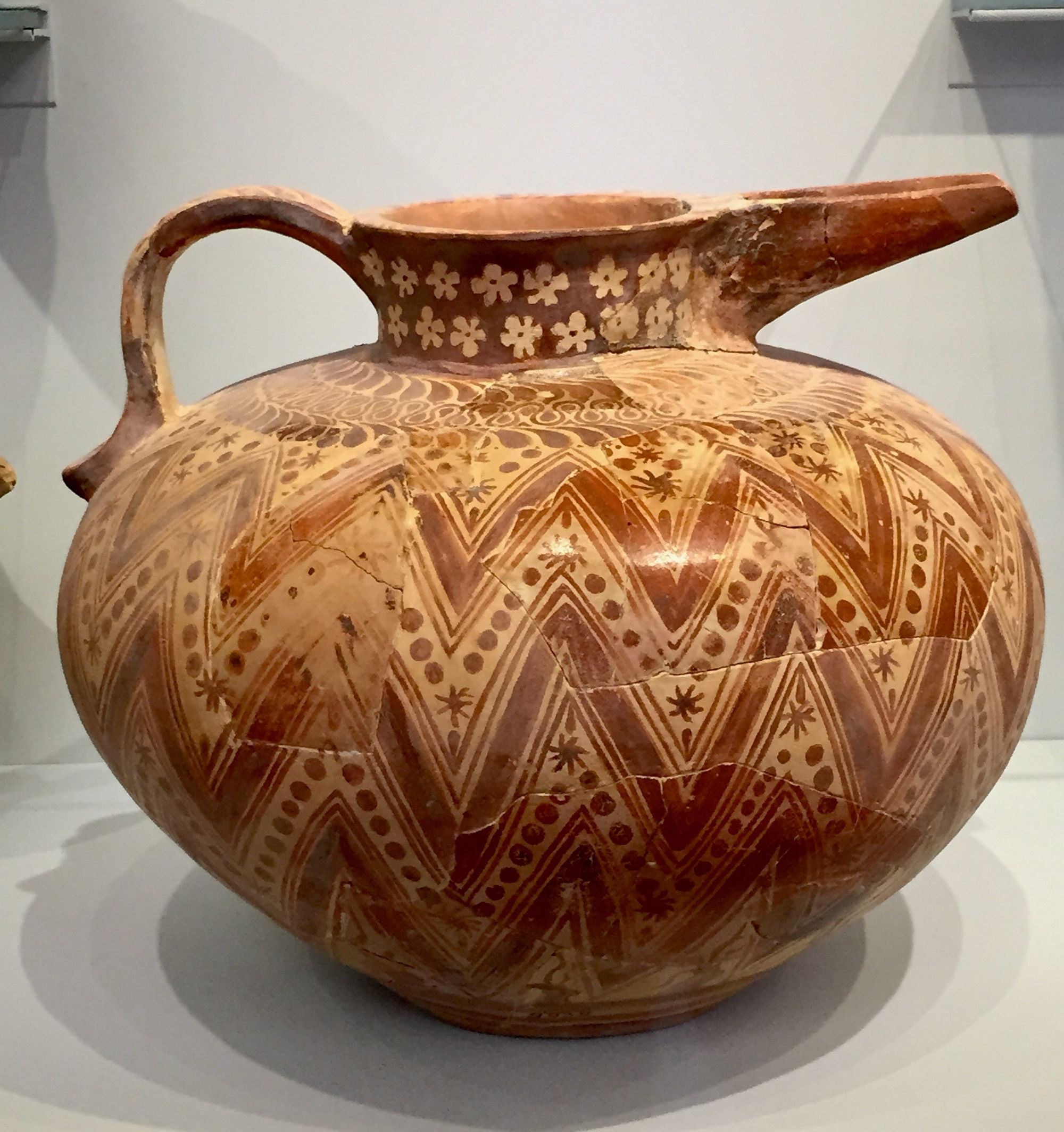
Figure 22 shows hints of the other Special Palatial Styles. There are sea urchins and corals from the Marine style, one-sided foliate bands from the Floral Style, and the reserved rosettes harken to the Alternating Style.
Figure 23 provides a beautiful example of the Alternating Style.
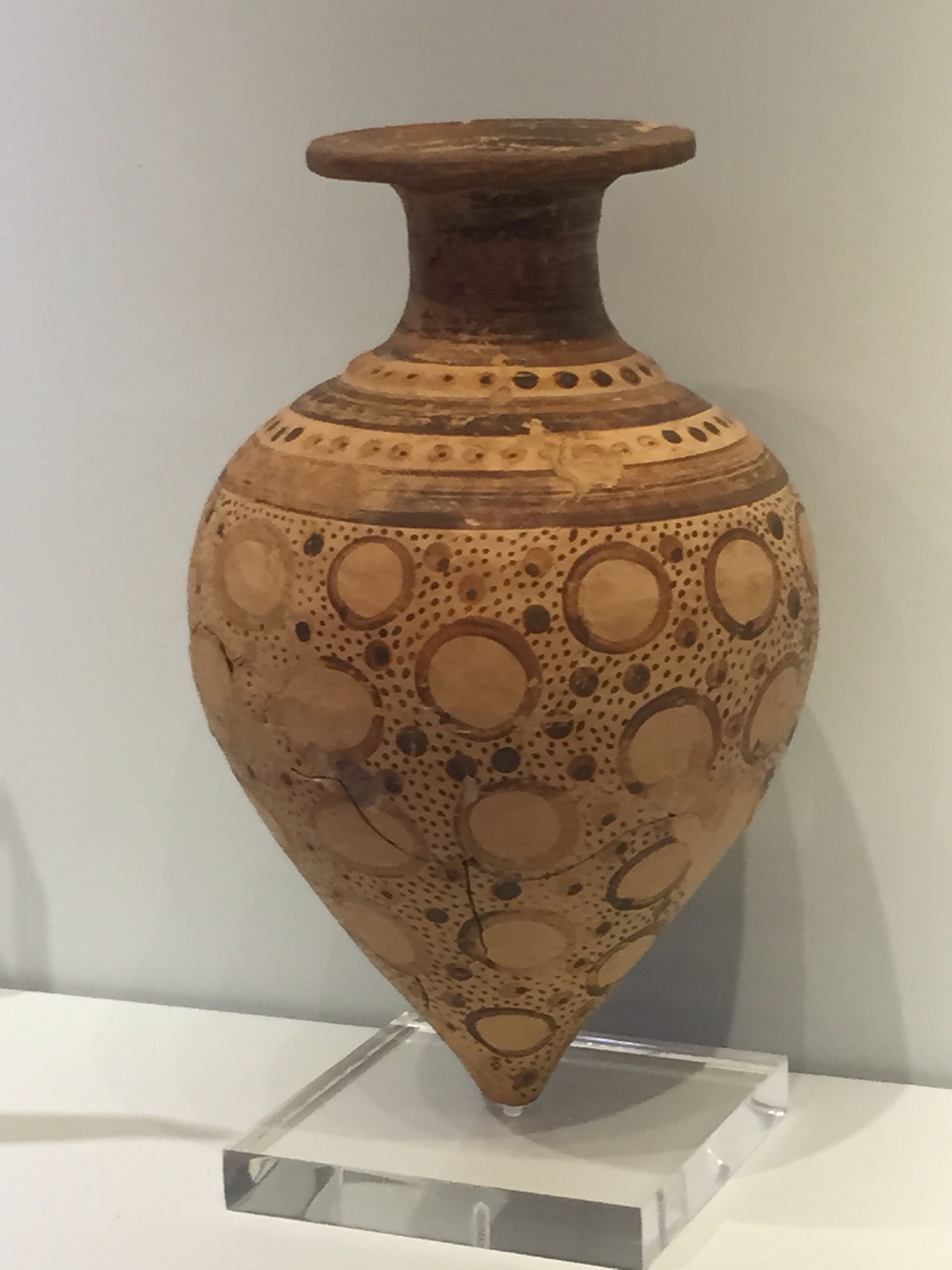
Large Palace Pithoi containers (Pithos is singular) were used to store agricultural product in bulk (Figure 24). They were critical to the economic apparatus of the Minoans from early on.
We have seen examples of Pithoi already, but not in this size and comparatively unfinished style. It’s not a new form of pottery, and very important to daily life, commerce, and trade. In the time of the palaces, very large Pithoi were centrally stored and protected near the palace courtyards and governing quarters.
The Pithoi shown in Figure 24 were found in Agia Triada and depict a typical storage rack. They are nearly one and a half meters tall, are decorated with rope relief bans and Linear A inscriptions can be found incised on them, presumably noting what they contained. They represent the largest ceramic pieces produced by the Minoans.
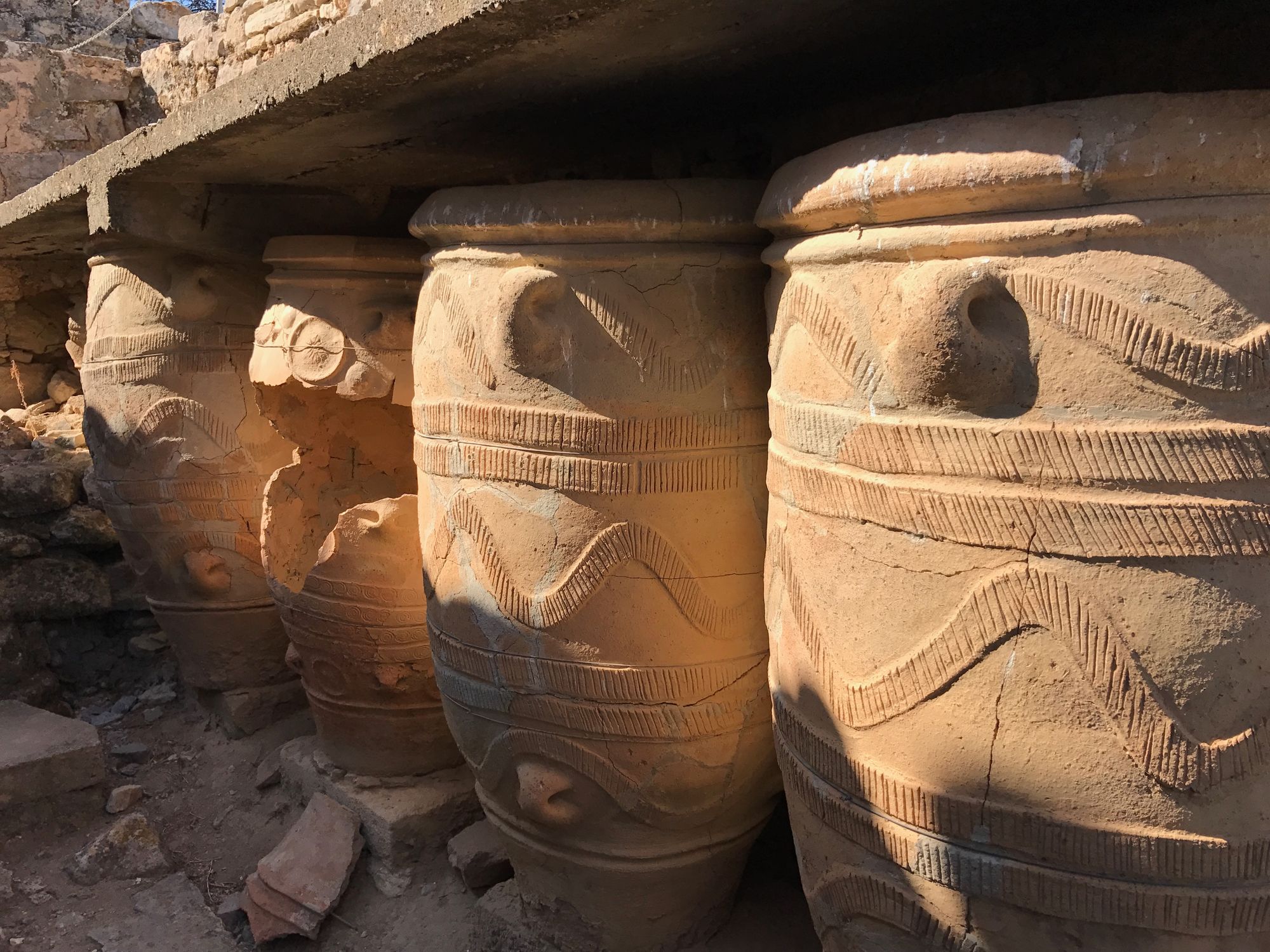
Late Minoan II, 1450 – 1400 BCE / Final Palatial Period
The merging, or absorption of, the Minoans by the Mycenaeans begins. Economic prosperity remains high, with occasional setbacks, trade and manufacturing flourish and the population remains large.
Overall, naturalism and variety are gradually abandoned in favor of standardized shapes and motifs which continues through LM III.
The Palace Style is the most well known in the LM II period and applies to a group of monumental jars. An example with a Marine motif is shown in Figure 25. Simplifications can be observed when compared to Figures 18 and 19.

More unusual examples are shown in Figure 26, which, with their spiky knobs, are decorative and abstract. The one on the left is tall, almost 50 centimeters, which implies it was a display piece used for libation ritual.
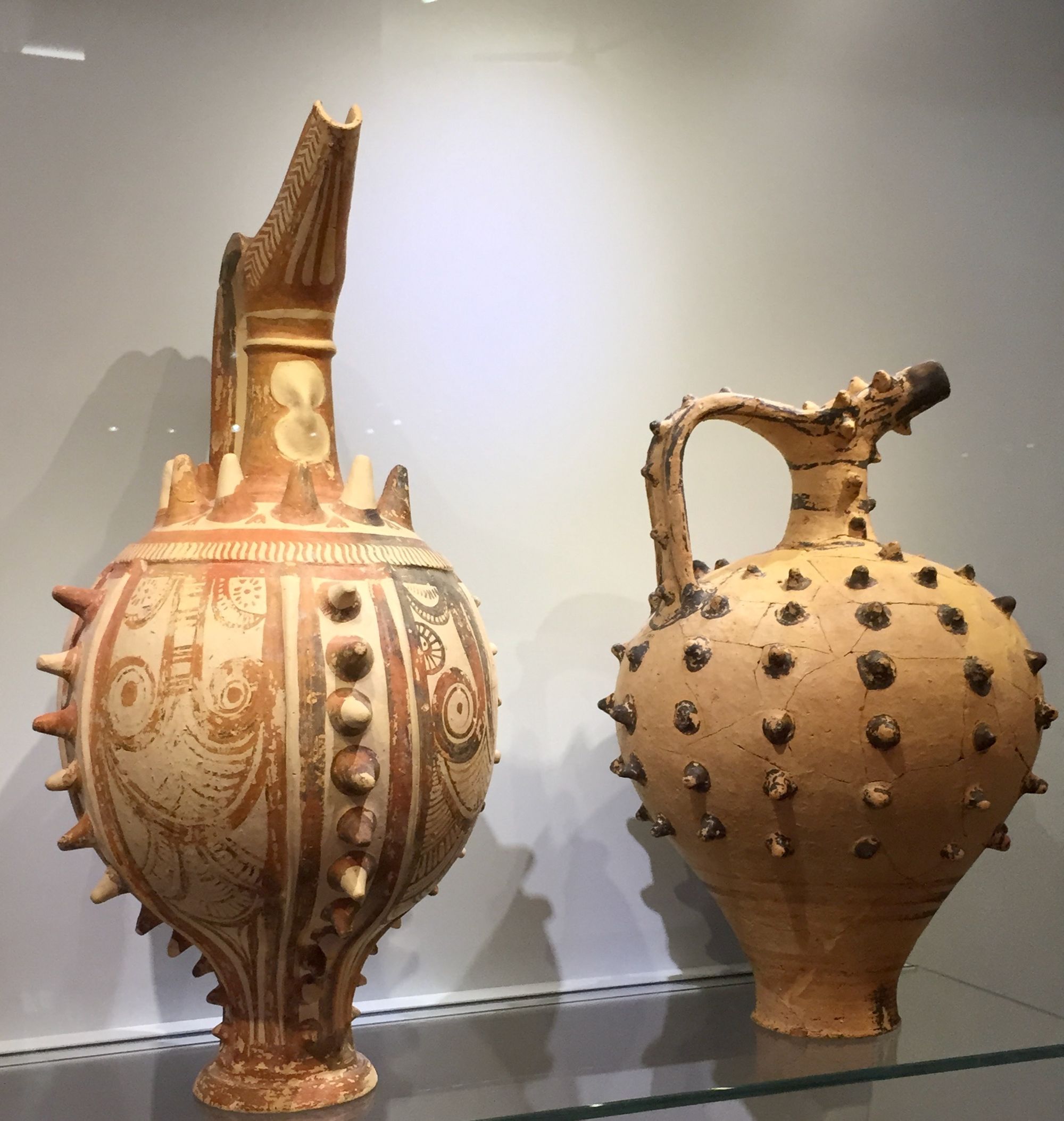
Late Minoan III, 1400 – 1100 BCE
This final 300 years continues an increase in pottery production and expanded commercial enterprise as the Minoan enterprise became intermingled with the Mycenaeans.
Pottery continues to standardize yet retains many of the creative elements we have seen thus far. The technical quality of the ware remains high. Perhaps due to the volume produced and the trend to standardization, the styles become more difficult to track and name uniquely.
We conclude with examples that provide a flavor of this final period. They are attractive, mature and well made, but somehow lack a vibrance observed from prior periods.
Figure 27 shows a variety of LM III jugs displaying mostly geometric motifs.

Figures 28 and 29 show more examples of Octopi on Kraters, Jugs and Stirrup Jars, simplified and standardized further in design, with tentacles in two rows symmetrically coving the vessel.
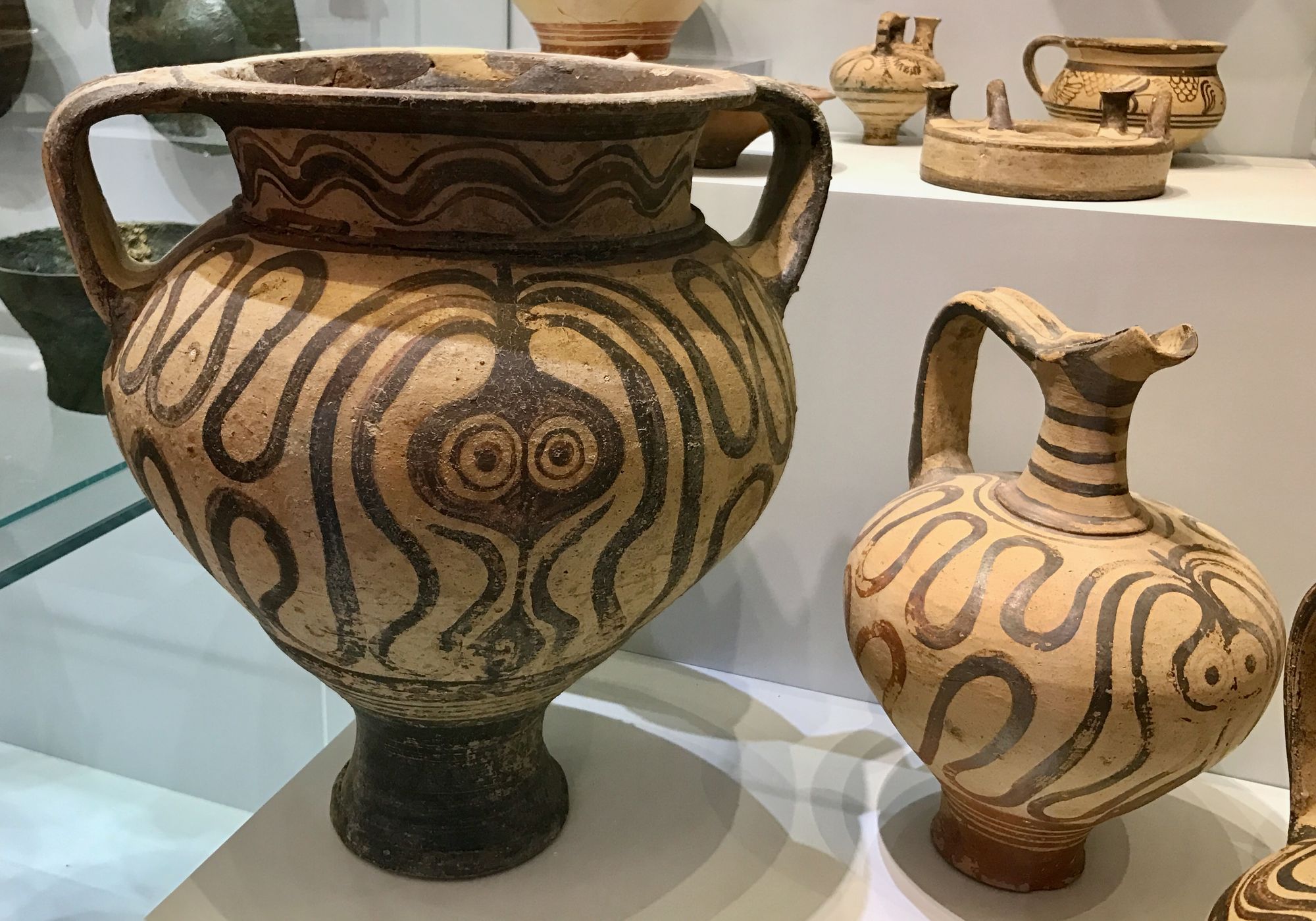

Minoan Kilns – One example
Throughout the entire Minoan Period, pottery was fired at earthenware or terracotta temperatures, employing slips rather than ceramic glazes. Firing was performed once in cross-draft, wood stoked kilns that could be manipulated to create oxidized and non-oxidized (reduction) environments.
The technical advancement of cross-draft kilns from the Final Neolithic pit-kilns was the separation of heat source (wood fire) from the pottery zone, drawing heat from the fire chamber to the pottery chamber and out through a flew. This allowed for hotter firing temperatures, due to improved heat retention, and improved atmospheric control. Pit-kilns were smaller, single chambered, with no drafting capabilities, and with the heating material being in proximity to the pottery.
Minoan cross-draft kilns are divided into two classes, Type I and Type II. Type I kilns were smaller than Type II. Type 1 are round or pear shape and half sunken into the ground. The advanced Type II kilns are called Channel kilns. They are larger, rectangular or horseshoe-shaped and possess multiple U-shaped channels from which heat was drawn into.
In total 51 Minoan Type I and II kilns from 20 settlement sites have been identified on Crete thus far.
An example of a Type II kiln from the Minoan Palace of Zakros, located on the eastern shoreline of Crete, and dated Middle Minoan III or Late Minoan IA (1750 – 1625 BCE) is shown in Figure 30.

This kiln was presumably domed (now ruined) with discrete openings to control airflow. A wood fire pit is in the foreground from which heat would be drawn into the channels and out the back or top in a flew. It's also presumed the pottery was placed along the tops of the channels, covered by the dome, as no evidence of a grate over the channel, while hypothesized, has yet been found.
Appendix I - References
- A LM IA Ceramic Kiln in South-Central Crete: Function and Pottery Production, by JW Shaw et al, American School of Classical Studies at Athens, 2001
- From the Land of the Labyrinth: Minoan Crete, 3000-1100 B.C., Alexander S Onassis Public Benefit Foundation, Hellenic Ministry of Culture, and Archaeological Museums of Crete, 2008
- Heraklion Archeology Museum - Collections
- Minoan Pottery Kilns: A Re-Evaluation of Their Morphology, Technology, and Function, by Ioannis Pappas, SYMPOZJUM EGEJSKIE, PAPERS IN AEGEAN ARCHAEOLOGY VOL. 2 (2019)
- The Bronze Age Begins: The ceramics Revolution of Early Minoan I and the New Forms of Wealth that Transformed Prehistoric Society, by Philip Betancourt, INSTAP Academic Press, 2009
- The History of Minoan Pottery, by Philip Betancourt, Princeton University Press, 1985
Appendix II - Minoan Timeline
From “From the Land of the Labyrinth: Minoan Crete 3000-1100 BCE”
| Period | Dates - BCE | Palace Period |
|---|---|---|
| Early Minoan I | 3000-2600 | Pre-Palatial Period |
| Early Minoan II | 2600-2300 | |
| Early Minoan IIII | 2300-2100 | |
| Middle Minoan IA | 2100-1900 | |
| Middle Minoan IB | 1900-1800 | Proto-Palatial Period |
| Middle Minoan II | 1800-1700 | |
| Middle Minoan III | 1700 – 1600 | Neo-Palatial Period |
| Late Minoan IA | 1600 – 1525/1500 | |
| Late Minoan IB | 1525/1500 – 1450 | |
| Late Minoan II | 1450 – 1400 | Final Palatial Period |
| Late Minoan IIIA1 | 1400 – 1375 | |
| Late Minoan IIIA2 | 1375 – 1300 | |
| Late Minoan IIIB | 1300 – 1200 | Post Palatial Period |
| Late Minoan IIIC | 1200 – 1100 |
